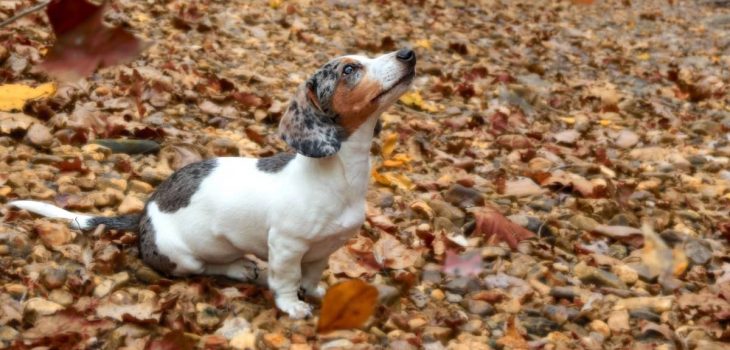Picking a unique sub-breed dog should always be accompanied by some health research. So, here’s our quick guide to the main piebald dachshund health problems.
This breed looks quite different from standard dachshunds but does this mean that it’s more sickly? White spots and coats in dogs are often associated with blindness and deafness, after all. Do piebalds have any negative genetic predispositions related to their coloring? Let’s examine the issue below.
Common Piebald Dachshund Health Problems
When looking at the dachshund common health problems we can encounter, it’s important to note that different types of Doxies can have different issues. Piebalds, however, share almost all health risks and issues with standard-colored dachshunds, with the exception of one problem which we’ll mention first below. So, here are the eight problems most common to piebald dachshunds:
- Congenital deafness – this is the only issue unique to piebald dachshunds that most other Doxies don’t encounter
- Intervertebral disc disease (IVDD)
- Progressive Retinal Atrophy (PRA)
- Glaucoma
- Cataracts
- Acanthosis Nigricans
- Lafora Disease
- Obesity
As you can see, the only additional risk for piebalds compared to standard dachshunds is that for deafness. The risk isn’t significant enough for concern, however, and kennel clubs worldwide accept the breeding of piebald dachshunds.
It’s generally accepted that as long as the white spots and coloring of the piebald Doxie don’t cover more than 80% of its coat, the risk for congenital deafness is limited. Such dogs are considered “Extreme piebald dachshunds”.
Aside from that, piebalds are as healthy as standard dachshunds. You may also notice the lack of “blindness” mentioned in the list above. That’s because piebalds don’t really have an increased risk of blindness as is usually associated with white-colored dogs. There is another type of dachshund sub-breed with white spots, however, that has a very serious risk of blindness – the double dapple dachshund. We’ll talk more about them below.
How Is The Piebald Dachshund Different From Other Doxies?
Piebald Doxies are a unique and rare type of dachshunds because of their coats. They result from the breeding of two dachshunds with a piebald recessive gene, also known as the White Spitting gene or the S locus.
This doesn’t mean that both parents have to be piebalds, however – solid-colored dachshunds as well as dapple dachshunds can also carry the S locus and can be identified as carriers with a simple genetic test.
Piebald Vs Double Dapple Dachshund
The difference between piebald and dapple dachshunds is in the type of gene that causes the white coat markings. With piebalds, the gene is recessive, meaning that both parents must have it. With dapples, the gene is dominant, so even a single dapple parent is enough for there to be dapple offspring.
Other differences between piebalds and dapples include:
- Piebald dachshunds will usually have more white spots
- Piebads’ white spots are usually more symmetrical than those of dapples
- Dapple Doxies can have blue or hazel eyes while piebalds are always brown-eyed (unless it’s a piebald/dapple mix)

Learn more about: When Do Dogs Eyes Change Color And What Causes This Amazing Transformation?
Double dapple dachshunds, however, are the offspring of two dapple parents. It is this combination that is very frowned upon and avoided by dachshund breeders as there are a lot of double dapple dachshund health problems that can occur, including much higher risks of deafness and blindness.
So, simply put – piebalds, dapples, and standard dachshunds are all relatively healthy with the exception of the risk of congenital deafness in piebalds. Double dapples, however, can suffer from a vast array of other genetic and health issues so breeders should always try to avoid mixing two dapples.
What Are The Average Annual Medical Expenses For Piebald Dachshund Health Problems?
Owning a piebald dachshund doesn’t really incur a lot of extra medical expenses, especially if there is no congenital deafness. So, if you’ve made sure that you get a healthy pup with good hearing and no negative genetic predispositions, you can expect very minimal medical expenses.
Should You Get Pet Insurance To Cover The Piebald Dachshund Health Problems?
This is generally a good idea, depending on what types of insurance policies you can get. Especially if you know that your dachshund has certain health risks or you’re not sure about its genetics and risks. It’s also a good idea if your dachshund is getting into its “Golden years”.
All this has nothing to do with the dachshund being a piebald, however – the same risks apply to standard dachshunds as well.
The Importance Of Health Certificates For Genetic Predispositions and Piebald Dachshund Health Problems
This is as crucial for piebald dachshunds as it is for all dachshunds and any other dog. If you are buying your dog and not adopting it, your best bet is to go to a reputable breeder who offers health certificates. Such a breeder should also be able to provide health certificates for the dog’s parents and even introduce you to the parents and the rest of their litter.
All this is helpful in making sure that you end up with a healthy puppy. Obviously, checking if the pup has congenital deafness is also crucial. Buying from a reputable breeder can cost a bit extra compared to pet stores and puppy mills but it’s worth it as it reduces your future medical expenses. Plus, you won’t be supporting an amoral breeding industry.
And, another good thing is that piebald dachshunds aren’t really more expensive than standard dachshunds as they are not that much rarer. You can find a piebald in pet stores for about $200 and at adequate breeders for somewhere between $1,000 and $1,500, which, again, is usually worth it.
What Is The Average Lifespan Of A Piebald Dachshund?
The average lifespan of piebalds is the same as with standard dachshunds – 12 to 16 years. Even if your piebald happens to have deafness, that won’t affect the rest of its health and expected lifespan. And, with good care, your Doxie can live well beyond this average too!
So, Should You Avoid This Breed Because Of The Few Common Piebald Dachshund Health Problems?
Considering that the only extra issue is the deafness and the risk is low in non-extreme piebalds, we’d say that it’s definitely worth it. Just make sure to only work with reputable breeders and get a healthy puppy. Or, alternatively – adopt from shelters and rescues.
Read more about: What Are The Main Dachshund Hind Leg Problems and What Can You Do About Them?




